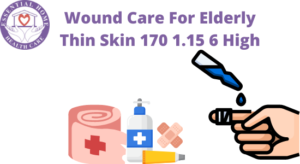No doubt it’s many people want to go to the best clinic for surgeries, So we offer you the best wound care in Chicago; at our center, you’ll get the most reliable services. As we know, aging skin changes increase the risk of skin injury, such as pressure ulcers, during elderly patients’ hospitalization.
Skin tears are the most prevalent type of wound in the elderly. If left untreated, skin tears can develop into chronic wounds, compromising the individual’s health and resulting in enormous healthcare costs. Skin tears will inevitably become a public health hazard as the American population ages, making their prevention and management critical. This article will examine the incidence, risk factors, prevention, and treatment of thin skin tears in elders.
Skin Rips Are Defined As
Skin tears are lacerations that extend through the epidermis (the outermost layer of skin) and into – but not through – the dermis (the innermost layer of skin). The dermis contains capillaries, nerve endings, sweat glands, and hair follicles. Friction or shear force can result in the epidermis being separated from the dermis, resulting in a skin jagged or angular flap.
Epidemiology of Cutaneous Abrasions
According to American studies, skin rips account for roughly 55% of all wounds in the elderly. A comprehensive recent survey discovered that the incidence of skin rips in the elderly ranged from 2.2% to 92% per year in long-term residential care institutions and from 2.1% to 4.6% among men and women living in the community. Research conducted in six long-term care institutions in the United States discovered that 9% of participants had skin rips.
Women are more susceptible to skin tears than men due to decreased hormone levels on the skin. The greater life expectancy of women exacerbates their higher rate of skin rips. How to do wound care for the elderly thin skin?
Skin Flap Wound Healing
The chance of sustaining a skin tear increases considerably as the skin weakens, dries, becomes less elastic, and thins due to decreased subcutaneous fat, collagen, elastin deposition, and sebum gland secretion associated with aging. Photoaging, specifically sun damage to the dermis due to outdoor lifestyles and jobs, was revealed to be a risk factor for skin tears in American research. This conclusion is relevant to Americans.
Skin tears have been linked to age-related issues such as dependency on daily living activities, sensory loss, limited mobility, the use of assistive devices, poor cognition, and medicine. Malnutrition can increase the risk by further weakening the skin and diminishing its shock-absorbing ability. According to an analysis of nine research, the most common characteristics of individuals with skin tears were a history of skin tears, reduced mobility, and cognitive impairment.
When handling elderly patients or removing adhesive bandages and tapes, healthcare practitioners may unwittingly cause skin rips. They can also occur due to everyday activities such as dressing and bathing, falls, colliding with objects, patient transfers, and the use of wheelchairs and other mobility aids. Dementia and other mental health issues can cause agitation, which increases the risk of skin rips.
Prevention
The American Academy of Dermatology has issued comprehensive advice for preventing skin rips in the elderly. The majority are common-sense recommendations, such as avoiding trip risks and gently removing bandages, while others, such as wearing protective socks and moisturizing, are backed up by solid data.
Over six months, researchers in Western Australia evaluated the effectiveness of a twice-daily moisturizing routine vs. ‘normal’ skincare in lowering the occurrence of skin tears in residents of 14 aged-care institutions. On their forearms, lower legs, hands, and feet, the intervention group got twice-daily use of a commercially available, standardized pH neutral, fragrance-free moisturizer; the control group received no standardized skin-moisturizing routine. The intervention group averaged 5.76 skin tears per 1000 occupied bed-days, compared to 10.57 in the control group — an almost 50% decrease in occurrence.
Treatment
The first step in treating a skin tear is to rinse it with saline solution or warm water and pat it dries gently. Before applying a dressing, if a viable skin flap exists, it should be restored over the dermis with forceps or a wet cotton bud.
Innovative technologies have resulted in highly effective bandages that form a seal around the skin tear, preventing bacteria and water from worsening it. Additionally, zinc has been successfully utilized to cure skin tears when applied as a paste or bandage. Zinc has been shown to possess protective, anti-inflammatory, and antibacterial properties that aid in the healing process by stimulating cell growth.
In a convenience sample of 20 elderly individuals with moderate to severe skin injuries, the researchers examined a topical bandage containing a wound-closure adhesive (2-octyl cyanoacrylate or 2-OTB). In 90% (18 of 20) of patients, a single treatment of 2-OTB resulted in complete healing.
No cellulitis or infection occurred in recipients of the 2-OTB bandage, showering and bathing habits were not interrupted, and dressing changes were unnecessary. The average cost per application was less than US$1 (2005), and each application required 1.5 minutes of clinician time.
Individuals with dementia and certain other mental illnesses occasionally seek to remove dressings used to cover skin tears; 2-OTB eliminates this issue due to its hardly visible, transparent film. Additionally, this enables easy monitoring of the healing process.
Conclusions
While skin tears in the elderly are familiar, uncomfortable, and can result in more severe sickness, they are primarily avoided with common sense. Moisturize the extremities to help prevent skin tears. The treatment of skin tears is simple and effective when standard wound cleansing methods and bandages are used.
Come and get incredible services at wound care centers Chicago il. You can also call us at (847)813-6301).

